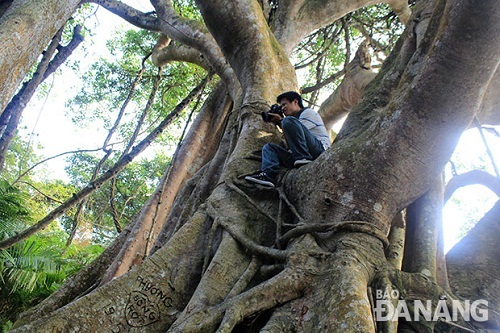Plans needed to promote Son Tra Peninsula's attractions
A number of domestic tourism experts recently proposed that the Da Nang tourism sector should make plans to fully tap the great tourism potential of the city’s Son Tra Peninsula whilst preserving its nature, culture, history and humanitarian values.
Nestled on the eastern side of the city, the peninsula is now home to 985 species of plants and 287 animals. Most notably, 22 rare plant and 15 rare animal species are listed in the Viet Nam Red Book. There are also 191 species of primary reef-building coral, 3 species of sea grass, 72 species of seaweed and many other types of marine creatures.
 |
| Someone has carved their name on the thousand-year-old banyan tree |
In addition to the variety of fauna and flora species, the peninsula also boasts such attractive tourist areas as the Ban Co (Chessboard) peak, the Linh Ung Pagoda, the Dinh Dong Museum, the Nhat Lam Thuy Trang Tra ecotourism site, radar station No 29, a helicopter base built by American troops in 1965, and the Y-Pha-Nho cemetery for French and Spanish soldiers who died in attacks against the city between 1858 and 1860.
Domestic and foreign visitors to the peninsula are also impressed by its beautiful pristine beaches which appeal on trips which discover the majestic natural landscapes.
However, many local residents have raised deep concerns over urgent issues including the slaughtering of many wild animals living in the peninsula’s primeval forest, illegal carvings on a thousand-year-old banyan tree, backpackers throwing litter, and the temporarily-suspended high-class holiday resort projects on the peninsula.
The Deputy Head of the Management Board of the Son Tra Peninsula and Tourism Beaches, Mr Nguyen Duc Vu, said that his unit has worked closely with local relevant agencies to discuss the launch of new tours to the area. However, the Management Board have organised only famtrip tours for delegations wishing to survey the new tourism products on the peninsula. Meanwhile, local travel agencies have not yet begun to organise tours around the peninsula in any sustainable manner.
According to the Head of the city’s Tour Guide Club, Mr Tran Tra, some of his club’s nearly 1,500 members have never been to the peninsula.
To deal with this problem, the Chairman of the city’s Travel Association, Mr Cao Tri Dung, stressed the need to train a group of qualified tour guides who can gain a thorough grasp of the potential and values of the peninsula in order to effectively advertise it to potential visitors.